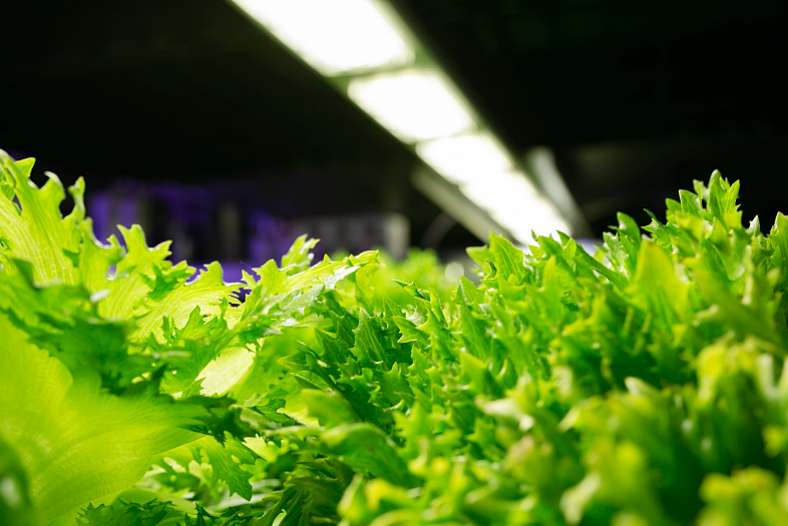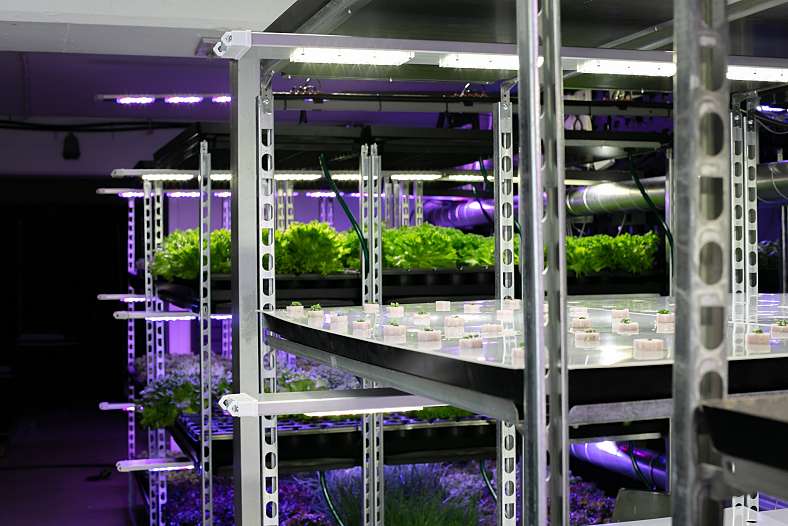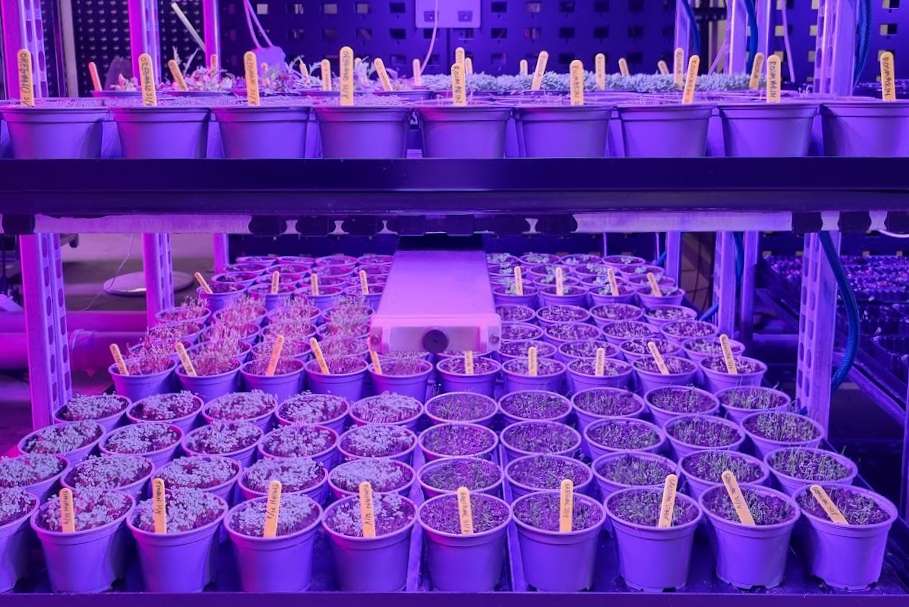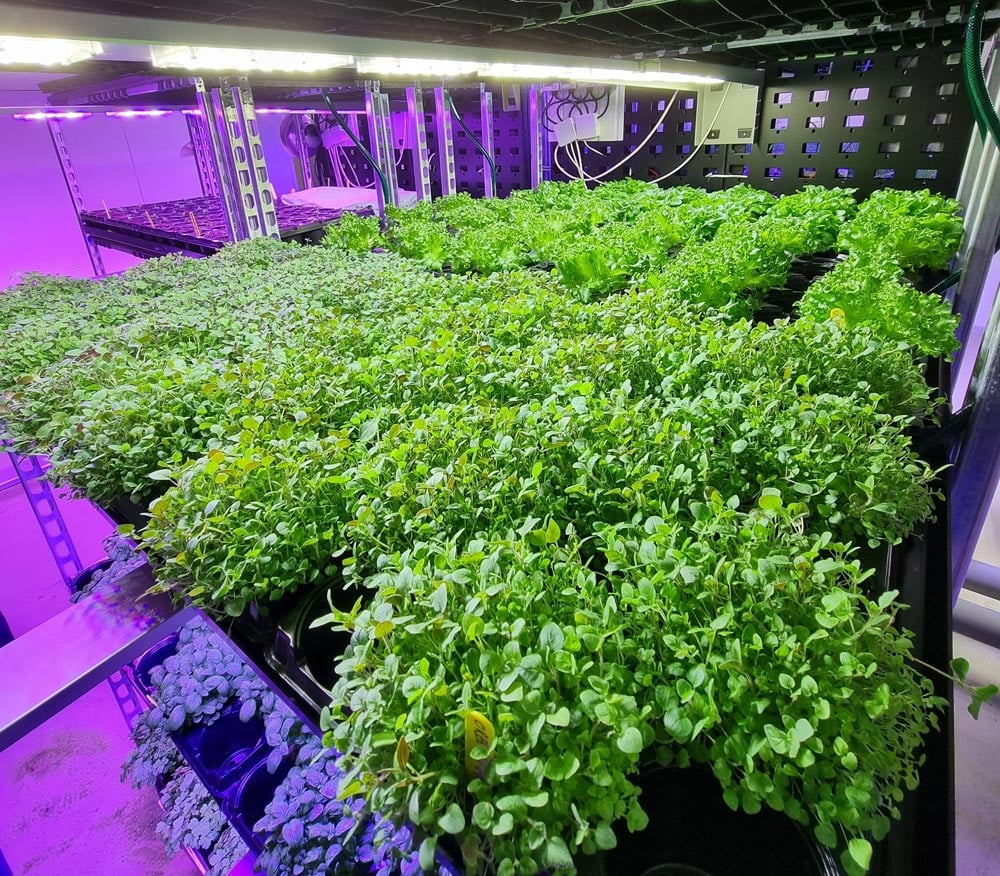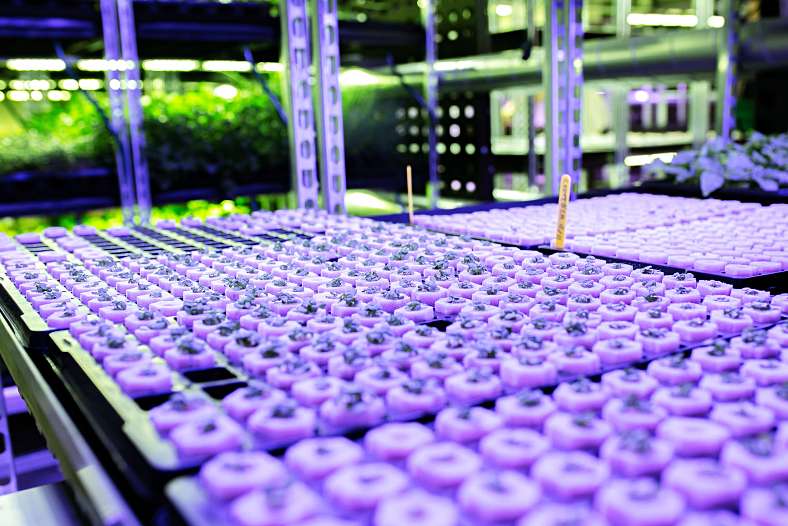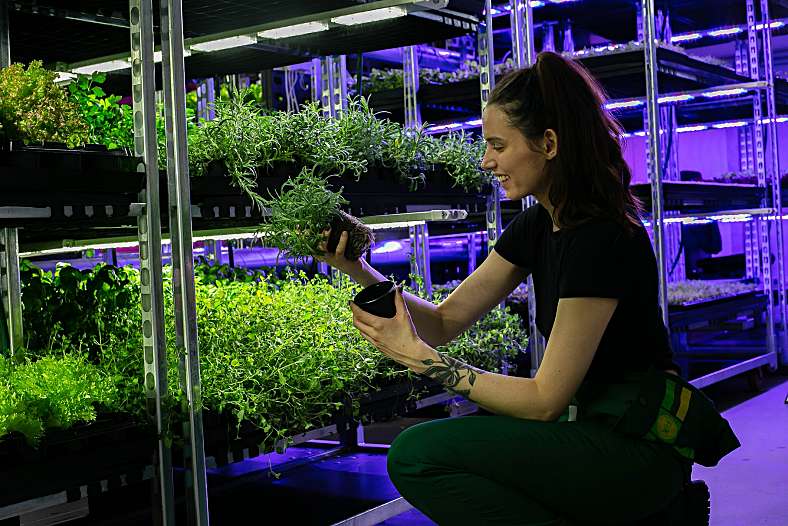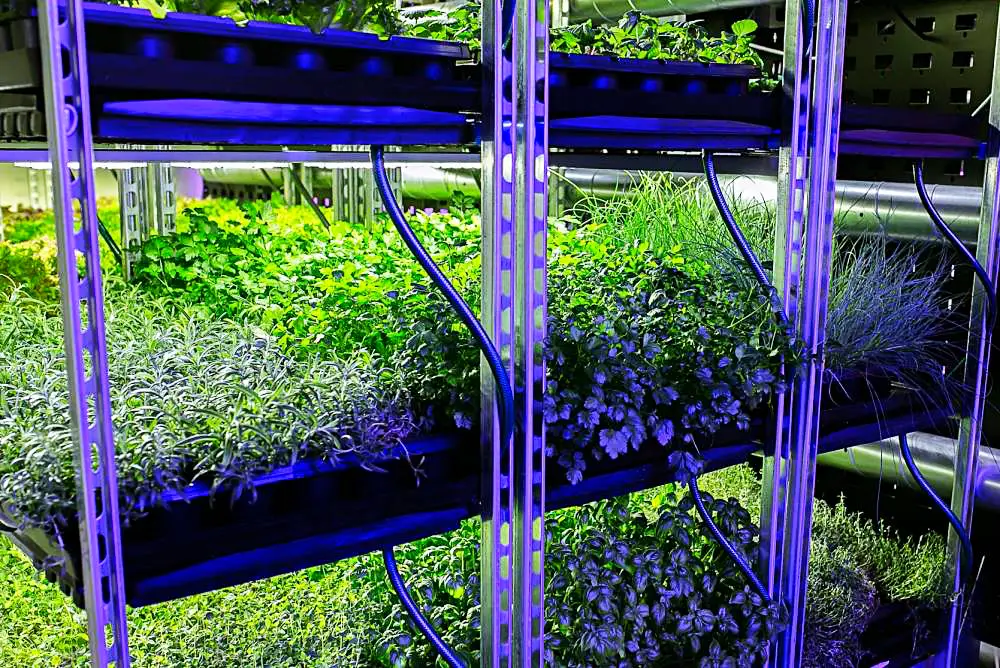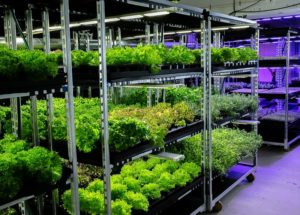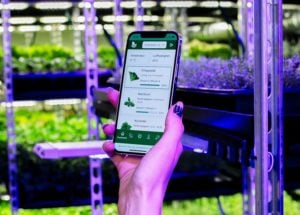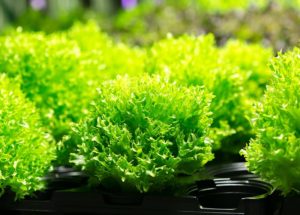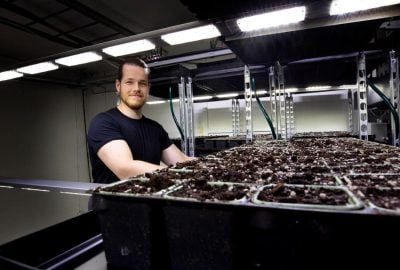It takes know-how to start vertical farming, but it’s still the business opportunity of a lifetime. Whether you are new to the game or moving from other types of agriculture to vertical farming, you’ll need to re-educate yourself. This article is a good place to start.
In short, to succeed with vertical farming you need a good location, a suitable building, and a functional farming system. Then, you need to establish a proper indoor climate and set up lighting and irrigation. You also need to consider growth medium and plant nutrients, as well as disease and pest control.
There is a lot to think about, but nothing you can’t handle. We’ve covered most of these topics in detail in our article library. For your convenience, we’ve also compiled this short version to get you started.
Related article: The best vertical plant factory solutions right now!
Sustainable factors of vertical farming
There are many benefits to starting a vertical farm. You will save a tremendous amount of space and water, which makes the production more sustainable. You will also promote local food production and reduce emissions from food transport.
Vertical farming makes effective use of water and nutrients. Resources are recycled as much as possible to reduce spillage and overuse of nutrients and fertilizers.
When you start vertical farming it is important to be aware of the rather high energy consumption. At the same time, it is motivating to learn that LED technology is bringing down energy costs all the time. The latest LED grow lights on the market made many vertical farms turn it around and make good profits.
Find out more in our article about why LED grow lights are best for vertical farming?
Plant growth benefits of vertical farming
Crops are more stable because they are sheltered from bad weather, pests, and plant diseases. All these factors contribute to less loss of crops. You can also harvest crops throughout the year with the same efficiency in summer as winter.
This in turn leads to increased profits.
Currently, your choice of plants for vertical farming is somewhat limited. That said, plant selection is quickly expanding. Soon, we will see many more plants from vertical farming in our everyday lives. Strawberries and mushrooms, for instance, are being developed for indoor farming as we speak.
What do you need to start a vertical farm? Check out Avisomo’s product page to find out!
Eight points to consider before you start vertical farming
In this guide, we will go through how to get started with vertical farming step by step.
We will look at:
- Choose your building wisely
- What plants can you grow?
- Infrastructure: Ventilation, water, electricity, and internet
- Choose your farming technique wisely
- Lighting conditions
- Plant nutrition
- How to deal with pests and plant diseases?
- Choose your vertical farming system wisely
Choose your building wisely
When you start with vertical farming, you first have to choose what kind of building to use. You can choose between using a building you already have at your disposal or building a new one.
The choice depends, among other things, on what kind of buildings you have at your disposal today. First, you need to find out how well your building is insulated. Then you must consider if the location is affected by direct sunlight or other external heat sources.
If you have a choice, always go for a naturally cool location. This makes it easier to control growth conditions and energy consumption in relation to each other.
Naturally cool rooms are usually humid. Therefore, we recommended that you insulate cold surfaces well to avoid condensation on the walls or ceiling.
In this way, you get good control and very little heat exposure from the outside on hot summer days.
Related article: How to reduce vertical farming energy consumption?
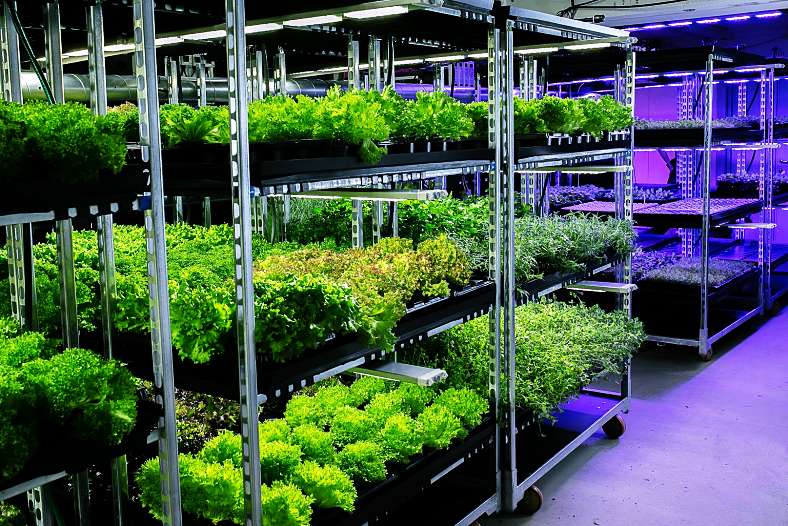
What plants can you grow?
After you have decided on a building, you have to decide on what to cultivate. The best way to choose your plants is to investigate market demand.
We recommend scoping out your market thoroughly. If there is interest in your products, get the companies to sign a letter of intent. Ask Avisomo if you need help setting up this document.
In these letters of intent, you can agree on price and volume. This gives you a good baseline for investing in systems.
You can read about the expected production volume in Avisomo’s systems in the article «How to create profitability in vertical agriculture». (Coming soon)
There is also a big difference in earning potential for e.g., plant types such as microgreens, sprouts, herbs, and salads, where all give good profits, but one gives significantly better ROI than the others.
It is always better to specialize in one plant type that you can deliver reliably.
Related article: Vertical farm plants: What can you grow?
Infrastructure: Ventilation, water, electricity, and internet
In addition to a suitable building, you need infrastructure such as ventilation, water, electricity, and internet to be able to run your production.
Water and electricity are self-explanatory, as you obviously have to provide water and light for your plants. You also need the power to operate your ventilation and air conditioning system. In addition, you need the internet to be able to operate your control systems.
For an efficient operation, you are completely dependent on using systems that automate the processes.
The system will control water, light, temperature, and so on. This makes it easy to plan the production beforehand.
It is these systems that make it possible to engage in vertical agriculture on a large scale, but it also helps on a small scale. The system ensures that you do not have to constantly monitor the plant growth, just make sure that nutrients and water are available to the system.
Ventilation and climate control
A very important factor for the success of your vertical farm is finding and maintaining the right climate. Especially regarding temperature and humidity.
It is very easy to forget that the LED lights will affect the temperature in your building both directly and indirectly.
Although LED lights are cooler than traditional growth lights, some energy is converted to heat.
Therefore, you need good ventilation and an air conditioning system to circulate the air and remove any excess heat.
In addition, the energy converted to light is absorbed by your plants. This in turn will cause the plants to transpire to get rid of the extra heat. This releases more water vapor into the air.
This process will lead to higher humidity, as the plants release as much as 97% of all the water they drink into the air around them.
To keep the temperature and humidity at the right level, you need a good ventilation system.
Photosynthesis works best under specific conditions. Therefore, researchers have come up with set values for correct levels. This is known as VPD (Vapor Pressure Deficit).
It is very important to balance your VPD well. Many researchers believe that imbalanced VPD is the number one cause of ineffective plant growth in commercial productions.
Less than optimal conditioning will hurt your crops. Most probably, it will also cost you extra money to fix in the long run. Our best advice is to get it right from the start.
Avisomo can help you make the right decision and offer good climate systems from our network of suppliers.
Choice of irrigation method
After you have a market in place, a location that is cool enough with associated infrastructure such as water, electricity and internet – it is time to find the right irrigation system.
Avisomo can help you from start to finish and has built many different types of systems. Essentially, indoor cultivation is based on different ways of supplying nutrients to the plants in the system.
Here we have 4 different possible methods: Aeroponics, Deep Water Culture (DWC), Nutrient Film Technique (NFT) or the traditional Ebb & Flow.
Aeroponics
As previously mentioned, in aeroponic cultivation, the roots of the plants are sprayed with a nutrient-rich mixture at regular intervals.
This is not a method Avisomo recommends for use on a large scale. The reason for this is that aeroponics requires a lot of maintenance to run reliably. Nozzle clogging, for instance, is a frequent problem with this growth technique.
Deep Water Culture (DWC)
DWC means to place the plants in trays above water. The roots will then stretch from the trays and dip into the water.
This growth technique is common in large commercial projects that specialize in one specific crop, such as lettuce or basil. It is a well-suited growth technique for automation.
Nutrient Film Technique (NFT)
NFT is a hydroponic technique using a shallow water stream containing plant nutrients.
The water is circulated past the bare plant roots in a waterproof channel or tray.
NFT is a good method because you always supply oxygen to the roots by the water flowing, a bit like what happens in nature near a river.
Ebb & Flow
Ebb & Flow is also a hydroponic method where you often use a substrate without soil. However, if you are cultivating in soil, this is probably the method you would use.
The substrate is flooded at regular intervals with nutrient-rich water. The plant drinks water from the substrate.
The substrate is allowed to dry between each time it is flooded.
The plants benefit from this dehydration, as it causes the roots to stretch, which in turn leads to better absorption of nutrients and oxygen.
Choice of cultivation system
When you start a vertical production, one of the first things you need to decide on is what kind of irrigation system you should go for. It is mainly a matter of supplying as much oxygen as possible to the plant’s roots, as oxygen is the most important factor for creating good and stable growth without problems.
Three common irrigation methods are used in vertical farming, each with their own subcategories. The main categories are:
- Hydroponic
- Aeroponic
- Aquaponic
Hydroponic
Hydroponic cultivation is done without soil. The plants grow in such a way that the roots are have direct access to water and nutrients at all times.
The nutrients are dissolved in the water, and the correct pH level is maintained so the plants can access all the nutrients.
Within hydroponic cultivation, there are several techniques we will look at later in the article.
The substrate used in hydroponics should be a neutral medium that does not contain any nutrients. In this way, hydroponics can provide exactly the nutrition you know the plant wants at all times.
Aeroponic cultivation
Like hydroponic cultivation, you do not use soil for this cultivation method. The difference is that plants stand with their roots in water when using a hydroponic method, whereas plants stand with their roots in the air when going for aeroponic cultivation.
The roots are regularly sprayed with a nutritious mixture. The plants take the tiny bubbles directly into their roots without water accumulating on the roots which can prevent oxygen supply.
This method is known for fast growth in research facilities. However, it comes with many mechanical challenges, and most facilities require a lot of maintenance to maintain good operational reliability.
Aquaponic cultivation
Aquaponic cultivation is similar to hydroponic cultivation, but fish or other aquatic animals add nutrients to the plants in this method.
Since both the plants and the fish must live in the same water, you must think very carefully about which fish, fish feed, and the type of plant you should use in the system. This is because different plants have different preferences for pH, nutrient concentration, and temperature – the same goes for the fish.
This means that there are only a few good combinations of fish and plants that actually thrive together and give good results.
Important factors in aquaponic cultivation
In addition to finding the right combination of plants and fish, there are also other challenges associated with aquaponic cultivation.
It is important to be aware that you need significantly more plants than fish for the water to be purified well enough for the fish. This means that in most cases you must have all the filters and systems that you would usually need to run an indoor fish farm without plants in the system.
The advantage is that you can grow plants in nutrient-rich water that you already have if you have a fish farm. Therefore, we usually recommend starting with fish farming and getting the infrastructure you need for it, before setting up a plant system.
The theory behind aquaponics is very good, but it is difficult to create good facilities in practice and even more difficult to scale up.
Avisomo has connected its cultivation systems at fish farms in the past and can therefore help you if you are working on an aquaponics project or want to connect a cultivation system to your fish farm.
Soil choices for vertical farm start-ups
You can also use traditional soil or peat to cultivate your plants in. Soil and peat are very compact and do not allow too much oxygen to the plant’s roots, so it is important to have a well-drained soil.
Furthermore, soil already has some nutrients in it. Therefore, one must choose fertilizer carefully so as not to create anaerobic conditions in the soil where nutrients build up and oxygen is not released.
In addition, you must have good control over the filtration of the water so as not to spread any problems throughout the system. When using soil or peat, it is therefore very important to rinse the recycled water through either a UV or boiling filter before it goes back into the production. The exception is if you use biological nutrients – then this will kill the bacterial flora.
By taking soil into a closed and controlled production, you also risk bringing in a lot of problems. This can be e.g. diseases, bacteria, organisms, fungal spores and insects. This usually means that you must resort to other means to prevent injuries, diseases or other problems.
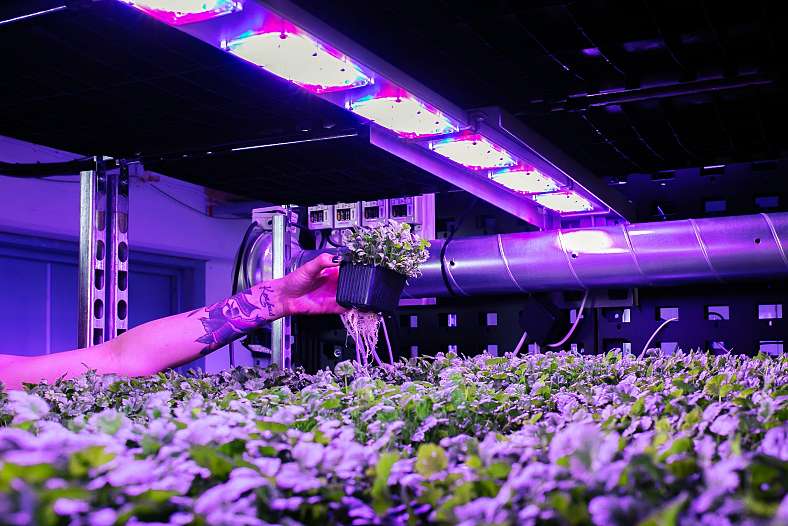
Lighting conditions
Since vertical farming takes place indoors, you need a different light source than the sun. Fortunately, LED lamps can be used, and they can mimic the spectrum of light in the sun’s rays that plants need to grow.
There is a lot of good research on what light does to plants, which wavelengths limit growth and which increase growth. In addition, there is research that indicates which wavelengths increase certain characteristics that one would like – for example, aroma, taste, nutritional content and biomass.
Related article: Vertical farming research
At Avisomo, we have several years of experience from growing under different light spectra, and we know which wavelengths are suitable for early growth and further on in the life cycle of a variety of different plants.
Therefore, we are happy to help you set up a vertical farm and contribute with our knowledge.
In addition, some plants require more intense light than others, so the number of lamps and dimming of the lamps is something you should focus on.
Avisomo LED grow lights
Avisomo’s LED lamps are developed for us here in Norway, with a patented lens that spreads the light exactly as we need it. Our control system has been developed with possibilities to dim the lamps easily and automatically as the plants grow larger and closer to the light.
We are the only place in the world where you can buy these lamps individually and they are of the highest quality for fast ROI. The lamps have a life expectancy of over 20 years and deliver as many as 3.2 micromoles of light!
The lamps come with mounts, so they are easy to install in the Avisomo growth stations.
Different light can give different results.
The exciting thing about choosing light is that different light can give different results.
Different light spectra are used to make the plants grow the way we want
There is research from the Philips GrowWise Center and many commercial projects from around the world that show what using different lights can do.
An example is red oak salad:
When this salad grows outdoors, it turns red due to stress caused by the sun and big changes in temperature. It also typically produces smaller crops than its green counterpart.
When it grows indoors, it mostly stays green because there is no UV light indoors. On the other hand, it develops quickly and can give the same or larger yield than the green variety.
Based on research from the Philips GrowWise Center, you can develop a light recipe for how to make the oak salad red in just a few days, just before the crop is ready for harvest.
In this way, you can use the LED lights to your advantage and create a good crop while at the same time getting the right look.
Related article: How to create ideal plant growth conditions in vertical farms?
Plant nutrition
Vertical farming is often done without soil. You can start with any kind of substrate you like. We like to focus on sustainable alternatives, such a:
- Soil
- Cellulose
- Fiber
- Growfoam
- Perlite / other volcanic rock
- Vermiculite
If you grow without soil, you have to add nutrients to the plants in a different way. This is usually done using growth nutrients that are mixed into water with the correct pH.
In hydroponic cultivation, the plants usually grow with the roots directly in water mixed with plant nutrients. Direct nutrition contact provides good growth conditions for most plants.
In hydroponic cultivation, it is important to use a complete fertilizer that adds all trace elements. You’ll need a good mixture that is water-soluble and can be used for both soil and hydroponics. For instance, Yara Kristalon plus, lime nitrate, and bitter salt. This mixture is a nice all-around combination that works for everything, whether you are growing tomatoes or lettuce.
The nutrient-rich water is recycled and reused in our systems. On top of this, we also make use of the water that transpires from the plants. This makes for extremely efficient use of water and little to no spillage.
In aeroponic cultivation, the roots are in the air, but are supplied with nutrients and water by spraying. This requires even less water than hydroponics.
In aquaponic cultivation, feces from fish or other marine animals are used to supply nutrients to the plants. The plant nutrition is altered by the fish type and the food they consume.
How to deal with pests and plant diseases?
All crops are prone to pest infestations and plant diseases. However, vertical farming makes it easier to combat these problems.
The cultivation takes place in closed buildings, with climate control, which reduces the chance of infestations. However, you must be aware that pests and plant diseases can enter the building via unintentional infection from personnel or seeds, or due to poor cleaning or maintenance.
Most likely, such an infection will occur via the ventilation system, brought in by people at work, or through open entrances.
To minimize the risk, there are several measures you can take. For instance, you can install air filters and airlock-based systems. Then, you can implement disinfection routines, including separate workwear for separate areas.
To prevent the spread of water disease, you can use UV filters, boiling filters, and other solutions that disinfect the water before it is recycled into the system.
Maintaining good climate control minimizes the risk of pests and plant diseases. It’s especially beneficial to keep the humidity at the right level.
Different levels give you an advantage
An advantage of vertical agriculture is that the cultivation takes place at different levels. This makes it more difficult for wingless pests and plant diseases to spread.
Biological plant protection – biological control agents
At the same time, this can prevent the biological control agents you use to get rid of pests from moving between the levels, and you may have to use more control agents.
Examples of such control agents are the predatory mite Phytoseiulus Persimilis to combat spider mites. The predatory mite cannot fly, and you may therefore have to use several of them to fight the pests.
However, the advantage of vertical farming is clearly seen when flying control agents remove pests since the control agents will naturally stay in the production facility.
Biological plant protection – banker plants
Planting “banker plants” is a good move to prevent the spread of pests. These plants are placed between other plants in your crop.
Banker plants are plants that are natural enemies of pests. They become an alternative host plant that attracts pests. Depending on what kind of crop you grow and what kind of pests trouble you, there are different banker plants you can use.
Plants such as e.g. oats and wheatgrass, can help you fight aphids.
Choice of control system
The Avisomo system is designed to accommodate various growth techniques.
Different plants are best cultivated by certain techniques. Take strawberries for instance. They do not like too wet roots. Lettuce, on the other hand, thrives in direct contact with water.
You should start by deciding what plants you want to grow. When in doubt, Avisomo can tell you about the advantages and disadvantages of the different methods.
When your plant types are determined, you must consider all the factors discussed in this article. Your building, grow lights, irrigation system, and computer system should work well together. Therefore, you need to think about how all the pieces fit together.
The Avisomo system is module-based. This means two things. For one, it is very adaptable. Secondly, you can start with just a few modules and expand your operation later.
This is how you plan for plant growth automation when you start vertical farming.
The next step would be to consider the finer points of your production plan:
- How much cooling does the system need?
- How much energy is supplied, and how much cooling will naturally take place in the building?
- Can the surplus heat (if any) be moved to another location in the building for reuse?
- How much do you expect to dehumidify?
The answers to these questions depend on several different factors, but the size of the production is often decisive. Avisomo can help you with every step. Especially if you plan to start vertical farming on a larger scale, our expertise will come in handy.
Grow your vertical farming knowledge! Sign up for Avisomo’s newsletter to stay updated!
Resources:
Agritecture: How urban agriculture is addressing the un’s sustainable development goals
EIT Food: Feeding the World and the Role of Vertical Farming
MDPI: State of the Art of Urban Smart Vertical Farming Automation System: Advanced Topologies, Issues, and Recommendations
Microsoft Features: Indoor vertical farming in Asia and beyond: Digging deep in data
Vertical Farming: Food Crops




